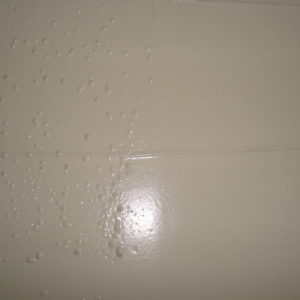I’m a do-it-yourselfer.
I’ve been drywalling for 25 years and I’ve done my share of basement rec-rooms and household repairs.
Over the last few years I have been having problems with applying drywall mud. I usually use the Ready-Mix All Purpose Compound.
The issue is with applying mud over a previously painted wall to fix a crack, nail pop (etc).
When I apply the first coat of mud I don’t see any problems.
However, when I apply the second coat I usually get a pile of bubbles.
These bubbles will not go away no matter how many times I go over them with the trowel… well I could spent 5 minutes on a spot and reduce them to fine bubbles but typically they do not go away.
When mud dries I have to sand off the bubbles and then apply a very fine coat to fill the pin-holes.
This is extremely annoying and I don’t remember it happening to me prior to a few years ago. I don’t think that I have changed my technique.
Is there a solution to this problem? Is it a problem with using Ready-Mix All Purpose mud. I’ve seen some posts that suggest that it is the paint, but then why is this only a recent thing (maybe in the last few years it started happening to me).
A picture is attached. In this photo I repaired a crack in a tapped joint by removing the compound covering the tape, putting in a new strip of tape and covering it with mud. Then on the second (and subsequent passes) I get the bubbles as in the photo. I think the photo is on the thrid pass. You can see that they do not occur over the joint (where there would be no paint).
Any ideas/solutions would be appreciated.
Thanks,
Ta.




















Replies
Ta
I would have suggested the previously painted surface was the cause-as it forces the mud to dry to the surface. And I"ve seen this happen when patching/blending in to a painted wall.
But yours is odd, just over the tape..........
Do you mix the mud, slow speed, add water.
Have you tried dampening the paper tape-assuming it's paper.
I always bed the tape in real Durabond, have experienced no problems with the finish coats, except over some paint.
One other thought, is the bedding coat dried well b/4 subsequent coats? I tend to rush some coats-use timed compound to save trips to the job (using easysand 90/45/20).
And of course, changed brands of bucket mud lately?
Make sure you're not whipping air into the mud as you mix it.
That is weird
compared to what I see - like Cal, normally see thi over painted plaster when blending, and the little bubles normally break and leave pits instead of stying up.
Some guys add a tablespoon of Dawn DW detergent to lower viscosity/surface tension a bit. I add a PVA ( white glue) sometimes.
And as noted, don't whip it up at high speed as that entrains air to the mix
edit to add another thought - is there any chance that your paper tape has been contaminated with a silicone or some sort of organic VOC that is causing this?
Thanks - Late Follow-up
Just to answer some of your questions.
First I'm using mesh tape, not paper tape.
I do not add water to the mud.
The problem occurs the next day after the mud is completely dried.
The bubbles are appearing over the painted areas, but on the second/subsequent coats (not the first).
The bubbles do not appear over the taped area.
I usually "Whip" my compound (I would say), to get it smooth. I guess that is a mistake. I typically work it on my hawk until smooth, but I have noticed bubbles at times on the hawk as well when I trowel it thin on the hawk.
So, I'm now thinking the issue is with the whipping of the mud. I do seem to recall though having the same problem with the mud right out of the box.
I'll try adding some Dawn DW Detergent (assuming I can find it) to the drywall mud... I'm guessing add it to the bucket when mixing.... or some white glue... (Who would have thought).
Thanks again for your replies and sorry for the late follow-up. Things get busy!
Because you are using the mesh tape, you are putting quite a bit of mud over it to cover. Then you are laying your knife too flat in order to try to smooth the surface without exposing the tape. Don't use the mesh tape. Lay the knife flat to butter the area but tip it up more on the edge when doing the finish stroke. The idea is to leave as little compound as possible, not to use it as a sculpturing filler. Laying the knife flat forces air into the mud.